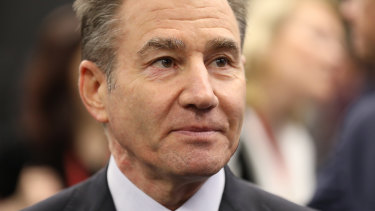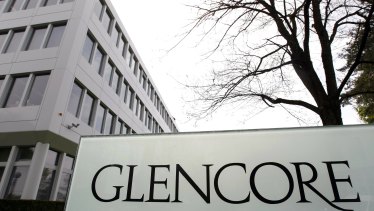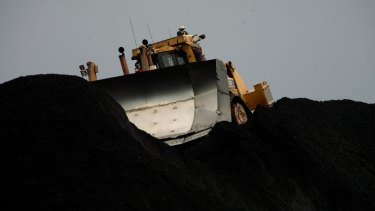Glencore, the world’s biggest coal miner, faces a ‘back to the future’ moment
Ivan Glasenberg has created an awkward conundrum for his successor, Gary Nagle. Does he hold or does he sell?
Glasenberg, chief executive of Swiss-based and London listed miner and commodities trader Glencore, announced on Friday (UK time) that he would retire in the first half of next year, handing over the reins of the company to the 45-year old Nagle.
It will be the end of an era for Glencore, which started life as an intensely secretive and controversial oil trader under tax fugitive March Rich. Glasenberg is the last of the talented team of senior executives who bought the business from Rich in 1994 and transformed it into the unusual beast that it is today, both major miner and giant commodity trader.

Credit:Bloomberg
It will also mark a major turning point in Glencore’s development. Under Glasenberg, CEO since 2002, Glencore pursued a dramatic transformation from trader and marketer to a mega-miner, owning resources ranging from coal to cobalt.
He also took it from a private-held partnership to a public listing through a merger with Xstrata, which it had sponsored and helped fund into a mining powerhouse. The merger created the sprawling hybrid of mining, agribusiness, logistics and marketing that Glencore is today.
In the process he out-manoeuvred Xstrata’s founding CEO, Mick Davis, to grab the CEO role of the merged group, a role that had previously been reserved for Davis.
For Glasenberg, and now Nagle if he is truly a “mini Ivan”, the assets within the group’s portfolio are less important than the portfolio’s ability to generate and protect profits and shareholder wealth.
Under Glasenberg, Glencore has been controversial – it is embroiled in allegations of corruption and money-laundering – but successful.
It had a brush with disaster in 2015, when the combination of a plunge in commodity prices and the debt inherited via the Xstrata merger saw Glencore shares plunge virtually overnight, but Glasenberg moved instantly and ruthlessly to slash costs, raise equity and sell assets to transform the group’s finances.
What has made Glencore unique among miners is its mix of trading, marketing and mining operations, which gives it a depth of market intelligence and market power unrivalled in the sector.
It is that model, and Glasenberg’s parting promise, that has created a complex challenge for Nagle.
On Friday, Glasenberg committed Glencore to reducing the group’s carbon emissions – including the “Scope Three” emissions of its customers – to net zero by 2050. With 90 per cent of the group’s emissions scope three and 95 per cent of those generated by the burning of thermal coal sourced from Glencore’s mines, that create a major dilemma for Nagle.

It’s a dilemma exaggerated by the accelerating investor aversion towards coal miners, which deters or even prohibits many big institutional investors from holding Glencore shares, which trade at less than half the level at which the shares traded in the immediate aftermath of the float. Glencore is the world’s largest coal miner, dominating the energy coal sector.
Glasenberg’s stated preference in meeting the goal of net zero emissions is to simply allow the mines to deplete until the run out of reserves and close but he is aware that shareholder pressure may force Nagle’s hands and lead to a sale or spin-out of the coal division.
That would be a company-altering decision. While coal now represents only five per cent of Glencore’s revenues and 10 per cent of its earnings before interest, tax, depreciation and amortisation (EBITDA) it was only two years ago that it contributed a third of the group’s earnings, with EBITDA margins of about 46 per cent.
Glasenberg is, however, pragmatic and extremely commercial and, as Glencore’s second-largest shareholder – his holding, which he said he would retain, is worth more than $5 billion – will be quite unemotional about the decision Nagle takes.
The reason Glasenberg pursued an integrated model of mining and trading is that it has provided the group with real market power and an ability to maximise its profits.
He, and Glencore, are unique because he sees everything the group does through a marketing lens and its ability to leverage its trading skills and the infrastructure that supports them. Owning mines is a means to an end, not an end in itself as it is for most big miners.
While Glencore dominates the premium end of the energy coal market, thanks largely to its Australian operations, it has been prepared to dial up or down its production volumes to maximise the price. For it, value takes precedence over volume.

The increasing industry and investor aversion to owning coal mines – Rio has exited the sector and BHP would if it could attract acceptable terms – hasn’t stopped Glencore from selectively expanding is presence to increase its market power, in the knowledge that the dearth of any big new mines in the global pipeline will inexorably tighten its grip on the market.
If the 45-year-old Nagle, dubbed “mini Ivan” is really a younger version of Glasenberg – Glasenberg has said in the past he was looking for a successor who he hoped would “look like me” to succeed him – he will have to toss up the loss of that steadily increasing market dominance and pricing power against the impact of retaining coal on his share price.
Glasenberg’s musing of a spin-out is telling, because that could provide Nagle with the least-worst option and effectively be a “back to the future” moment for Glencore.
If it demerged the business to its shareholders but retained the rights to markets its output it would re-establish the relationship it once had with Xstrata. It would sacrifice much of the profit from the mines but would still have a dominant and lucrative trading position and less capital tied up to support that position.
Glasenberg said on Friday that Glencore would continue to market third-party coal, so it is unlikely the group would cleanly sell-out of coal or spin it off without tying up the marketing rights into the distant future.
Glasenberg is a Friedmanite – he has made it clear that the only real business of Glencore is to make money for shareholders.
The goal of net zero emissions by 2050 doesn’t signal that he or Glencore have suddenly been converted to environmentalism. For Glasenberg, and now Nagle if he is truly a “mini Ivan”, the assets within the group’s portfolio are less important than the portfolio’s ability to generate and protect profits and shareholder wealth.
Market Recap
A concise wrap of the day on the markets, breaking business news and expert opinion delivered to your inbox each afternoon. Sign up here.
Stephen is one of Australia’s most respected business journalists. He was most recently co-founder and associate editor of the Business Spectator website and an associate editor and senior columnist at The Australian.
Most Viewed in Business
Source: Thanks smh.com